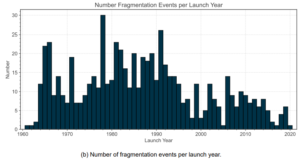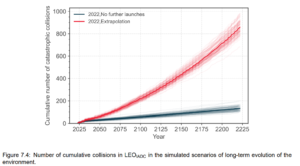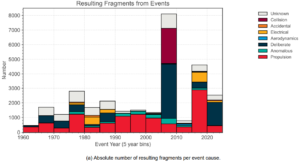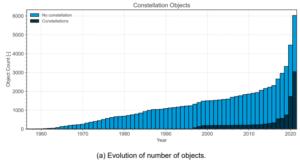Insight
September 1, 2022
Primer: Orbital Debris
Executive Summary
- Orbital debris – man-made objects in the Earth’s orbit that no longer serve a useful function – is becoming a more prevalent hazard for countries and commercial firms as they push to expand their satellite operations, threatening the viability of investments and future missions.
- The adoption of domestic and international guidelines to mitigate this hazard has reduced the average amount of orbital debris created per mission, but these measures are largely voluntary, meaning generators of debris face virtually no consequences for their behavior.
- Congress should work with the National Aeronautics and Space Administration and commercial partners to promote transparency and information sharing about the debris their activities create; continue to engage in international efforts to monitor and limit debris creation; experiment with market mechanisms to create incentives for private actors to abide by debris-mitigation guidelines; and embrace new technologies and innovations to remediate debris moving forward.
Introduction
President Biden’s recent actions on climate change take a small step in addressing a global problem that will require cooperation and innovation to solve. World leaders face a similar challenge that will require strong cooperation in the so-called orbital commons: orbital debris, or “space junk.”
The space economy is taking off. Between the creation of low Earth orbit (LEO) satellite constellations, the expansion of space tourism, and plans to build private space stations and research facilities, firms are vying to establish permanent fixtures among the stars. Orbital launch attempts around the world have increased significantly over the past five years and show no signs of slowing down. Yet this increase in activity is threatened by orbital debris.
Orbital debris is any human-made object in the Earth’s orbit that no longer serves a useful function, such as nonfunctional spacecrafts, abandoned launch vehicle stages, mission-related debris, and fragmentation debris. Mission-related and fragmentation debris include such things as paint chips, segments of fuel tanks and batteries, scraps of metal, detached launch hardware, and tools or waste discarded from missions. Because of their speed and location in LEO, and increasing presence in geosynchronous equatorial orbit (GEO), each piece of debris represents a potentially catastrophic risk to safety and functionality. LEO is home to thousands of satellites that are critical for broadband internet, communications networks, infrared imaging, and military surveillance. GEO is farther away from Earth, but houses satellites supporting electronic intelligence, optical imaging, global positioning and navigation, and commercial broadcasting. Put simply, a piece of debris could do irreparable damage to satellites that provide broadband internet, real-time GPS navigation, and even the International Space Station. If left unresolved, orbital debris accumulation poses a serious threat to future economic growth and national security.
While there are several international treaties, memorandums, and guidelines for minimizing orbital debris accumulation, they are voluntary and thus lack the teeth to hold parties accountable. The adoption of orbital debris mitigation guidelines domestically and internationally has reduced the average amount of debris produced per mission, but the significant increase in launches since the mid-2000s has increased the total amount of debris in orbit. This accumulation threatens future investment and mission safety. The U.S. has been a leader in this area and should push for greater adherence to existing guidelines and explore new initiatives to promote cooperation and collaboration to minimize debris creation.
Congress should work with the National Aeronautics and Space Administration (NASA) and commercial partners to improve mitigation practices as well as promote research and development (R&D) in novel remediation technologies before debris accumulation becomes an insurmountable challenge. Some courses of action could include promoting greater information sharing and transparency about the debris operations create, continuing to work independently and with other nations to establish and enforce debris mitigation guidelines, instituting market mechanisms to incentivize better mitigation practices and technology, and investing in and testing innovations to actively remove debris from LEO.
This primer discusses the state of orbital debris, the current regulatory environment governing orbital debris, and recommendations for legislators on ways to better mitigate and remediate orbital debris going forward.
Orbital Debris: A Crash Course
Orbital debris is a type of space debris, specifically man-made debris that occupies space in orbit around the earth. Because orbital debris is a byproduct of human activity in space, it is largely concentrated in LEO (160 to 2,000 km above surface), home to satellites critical for terrestrial communication and transportation networks. Yet debris of all sizes has steadily increased in GEO (35,000 km above surface) as well. GEO’s higher altitude makes it a target for vehicles and satellites de-orbiting after their mission ends. But the greater distance from Earth makes mitigation and remediation difficult and costly. While the composition of debris in each region varies, both are experiencing an increase in objects launched and debris accumulation, imperiling operations and increasing uncertainty for future space developments.
NASA describes LEO as an “orbital space junk yard,” and debris continues to accumulate there, in GEO, and between the two. There are over 26,000 “large” pieces of debris, and more than half a million “smaller” fragments of debris in orbit. Adding to this is another 100 million pieces of debris that are .04 inches, or one millimeter and larger in diameter, which are untracked within LEO and GEO orbit. Currently, NASA tracks and catalogues larger pieces of debris with help from the Department of Defense (DoD). While NASA has improved its debris assessment software and models, millions of untracked debris fragments pose a compounding threat to active and future operations.
Free Fallin’: Mitigation Guidelines to Prevent Orbital Debris and Their Shortcomings
The United States has pioneered debris mitigation efforts at the domestic and international level but with limited success. The United States was one of the original signatories of the Outer Space Treaty (OST), along with the Russian Federation and the United Kingdom, in 1967. Other than Russia, no other country has launched as much payload into orbit as the United States. The United States’ role in the proliferation of debris led NASA to erect the Orbital Debris Program Office in 1979, which monitors the orbital debris environment and works to establish technical consensus around debris mitigation strategies and guidelines. In 1995, the United States published a set of orbital debris mitigation guidelines, which became the “U.S. Government Orbital Debris Mitigation Standard Practices (USG ODMSP)” in 1997. This guidance became the framework for the Inter-Agency Space Debris Coordination Committee (IADC) guidelines for mitigating orbital debris, which were adopted by thirteen countries in 2002. These efforts were worthwhile, and as seen in Figure 1, the number of fragmentation events per launch declined in the mid-’90s and have remained low while payloads and launches increased. But this has not prevented the accumulation of debris, and as more objects are launched into orbit, the chances of catastrophic collisions steadily increase, as illustrated in Figure 2.
Figure 1
Figure 2
Russia and China have contributed significantly to the growth of debris in recent years. In 2007, what was called “the most devastating impact on the LEO environment,” a Chinese anti-satellite test (ASAT), created more than 2,700 pieces of catalogued debris. In 2009, a Russian spacecraft crashed into an American commercial satellite, creating almost 2,000 pieces of catalogued debris. The OST established that regardless of purpose, the state of a mission’s origin is liable for any damage an operation causes while in space. Neither the treaty, nor any other set of guidelines, however, include any avenues to mediate these issues or punish violators. Both countries adopted the IADC guidelines in 2002, but the lack of enforcement mechanisms meant impacted parties had little to no recourse. These two events have increased the large orbital debris population in LEO by approximately 70 percent, represented in Figure 3. While China has moved away from debris-generating ASAT, a Russian ASAT in 2021 created over 1,500 pieces of large space debris, increasing the number of avoidance maneuvers satellites and other vehicles in LEO perform. These instances illustrate the limits of mitigation guidelines alone, especially when countries that violate the guidelines face no repercussions.
Figure 3
Beyond countries, businesses’ proliferation of private satellites increases crowding and the potential for more collisions. If there are no consequences for creating debris, private companies have no incentive to do more than the bare minimum to comply with existing guidelines. Further, the current trend of debris proliferation is unlikely to reverse as market entrants and operations grow. In 2021, there were several instances of near collisions in LEO involving Starlink’s constellation of satellites. The company set a record for the number of rockets launched this year, and with their recent acquisition, shows no sign of slowing down, as seen in Figure 4. With this increase in activity, the chances for debris generation rise, a problem that can have impacts in orbit and on the ground. As commercial space launches and operations continue to account for a larger share of activity, a world of greater collisions and debris will become a reality under the status quo.
Figure 4
Ready for Liftoff: Recommendations for Congress and NASA
Congress and NASA have several options to address orbital debris. Those options follow two paths: mitigation (preventing the accumulation of debris preemptively) and remediation (actively removing debris from orbit). Both paths include tradeoffs that could hamper meaningful progress if not weighed correctly. But both mitigation and remediation are needed to tackle the threats posed by orbital debris.
Regarding domestic mitigation, Congress could first focus on transparency, as information sharing is critical to building trust, planning missions, and holding parties accountable for their operations. One researcher suggests releasing information on waivers given to NASA and DoD that exempt certain missions from orbital debris guidelines. Congress could also examine the current process for granting waivers and ensure it does not incentivize more risky operations. If the rules are interfering with innovation or national security, then relevant agencies and officials should review these and draft new ones. If not, then the onus should be on NASA and DoD to explain why they should continue receiving waivers.
As another component of increasing transparency, NASA could look to partner with commercial operators to bolster their logistics and orbital debris tracking capabilities. Many companies in the United States and around the world are competing to provide more accurate and up– to– date logistical information on orbital location and collision avoidance. By partnering with private firms, Congress and NASA could receive better information while rewarding innovative companies and novel technology.
Beyond domestic mitigation efforts, Congress and NASA should continue to engage with the European Space Agency (ESA) and other partners on international measures. One avenue that shows promise is the emergence of the Space Sustainability Rating Initiative (SSR) led by the ESA, World Economic Forum, and research partners in the United States and Europe. The rating system will score the sustainability of space flights based on factors such as data sharing, measures taken to avoid collisions and de-orbit satellites, and features making active debris removal (ADR) feasible. The rating could act as an incentive for companies and nations, leading to lower insurance costs or more funding. Several companies in the commercial space and aviation market support the SSR effort and have expressed interest in participating. Congress could have NASA evaluate the rating system to see if it improves upon current efforts to promote mitigation, and if so, consider partnering with the initiative. The orbital environment is shared among all nations and promoting effective collaboration could lead to significant benefits.
Finally, Congress could incentivize operators to prepare for debris mitigation and de-orbit measures, as well as force companies to bear responsibility for adding debris to the orbital environment through fines or other penalties. As an example, Congress could levy fines for debris-generating satellites, create a deposit system under which a company receives its deposit after its mission has safely concluded, or utilize cap-and-trade credits for debris like those used for carbon and green-house gas emissions. Another path could be to create “bounties” for debris, using an auction or bidding system to allow companies to compete for junk. These ideas incentivize companies to improve debris mitigation and ascribe a “cost” to the tons of debris orbiting Earth. By leading on these efforts, the United States can put itself in a position to continue to attract innovators and benefit from the unintended gains created by new technology.
Turning to remediation, there are companies and researchers vying to develop technologies capable of ADR. The White House’s 2021 and 2022 National Orbital Debris Research and Development Plans highlight the need for R&D investment in ADR technologies. A provision in the recently passed CHIPS and Science Act of 2022 increases general NASA Science Directorate funding available for government, university, or private R&D projects, and other provisions include funding for research on innovation in aviation technology, materials, and design. These funds can be directed to companies working on ADR technology, new satellites and rockets better suited to avoid debris, and materials for spacecrafts and satellites that are more resilient and create fewer pieces of debris in orbit. Congress and NASA could work to direct funding toward ADR and technologies that create less debris.
Conclusion
Orbital debris is becoming a more prevalent hazard as countries and commercial firms push to expand their satellite operations, threatening the viability of investments and future missions. Current regulations have allowed debris to accumulate in near-Earth orbit without penalizing those who generate it. To mitigate the accumulation of debris, Congress should embrace a variety of approaches. NASA should engage with public and private counterparts operating in near-Earth orbit to share information as well as pursue agreements that actively enforce mitigation best practices. Another is utilizing market forces to price debris generation, so operators bear the cost of generating debris, while incentivizing better habits and new solutions. Finally, promoting innovation to remediate debris through novel technologies is critical. By taking an all-of-the-above approach, Congress can ensure the United States is well positioned to be a leader in space for years to come.














